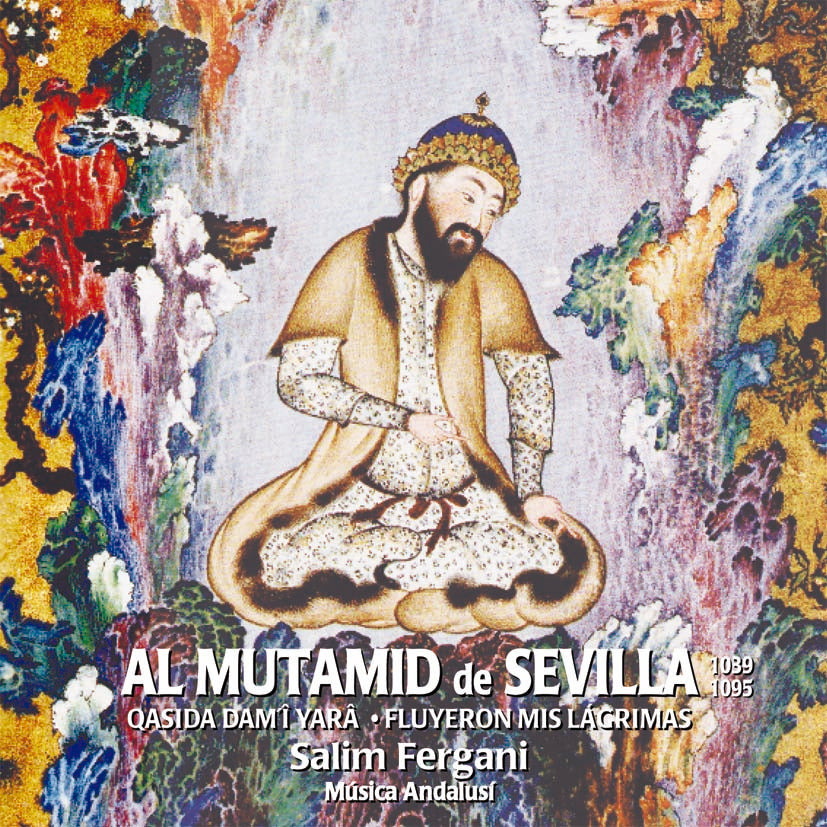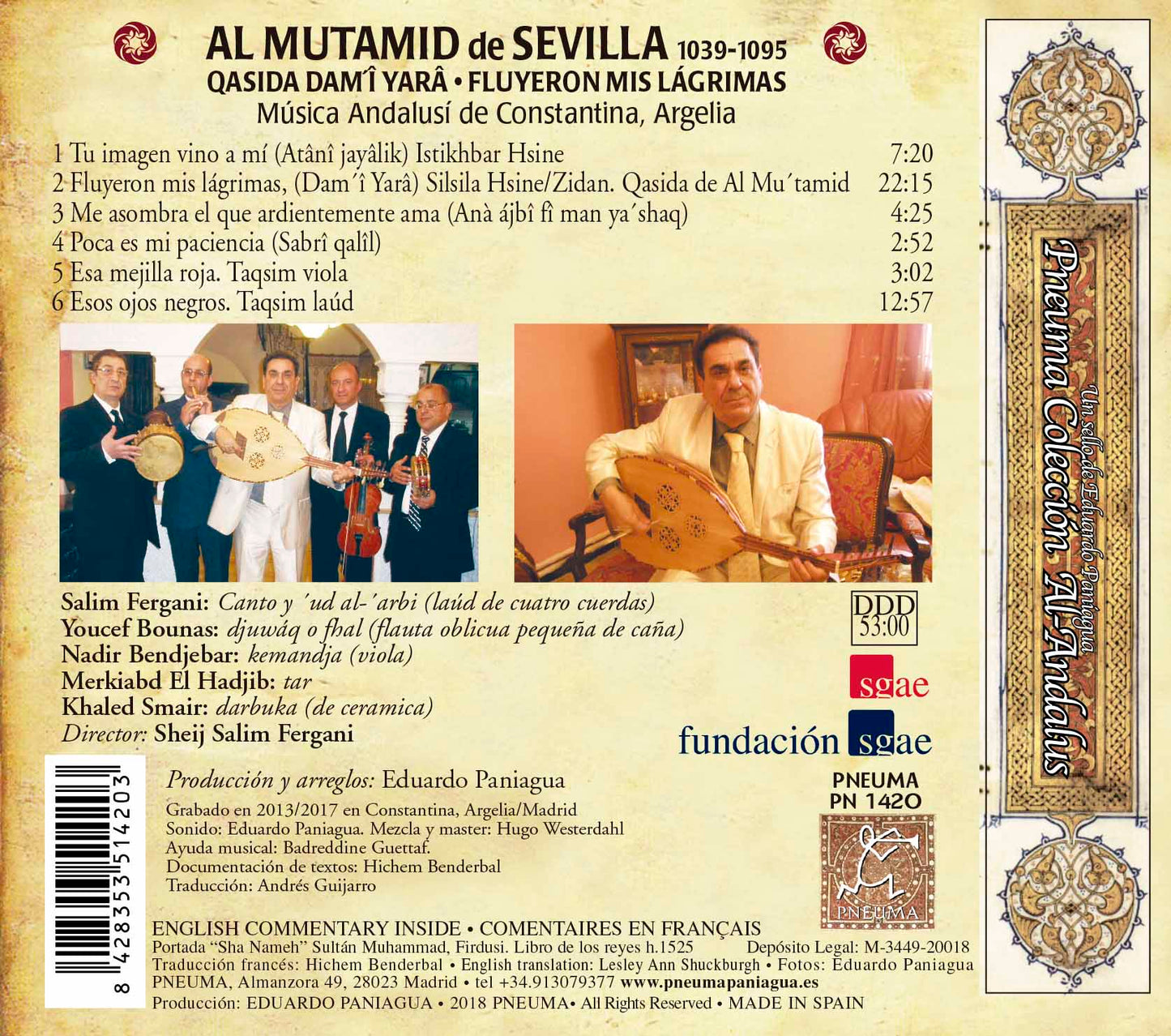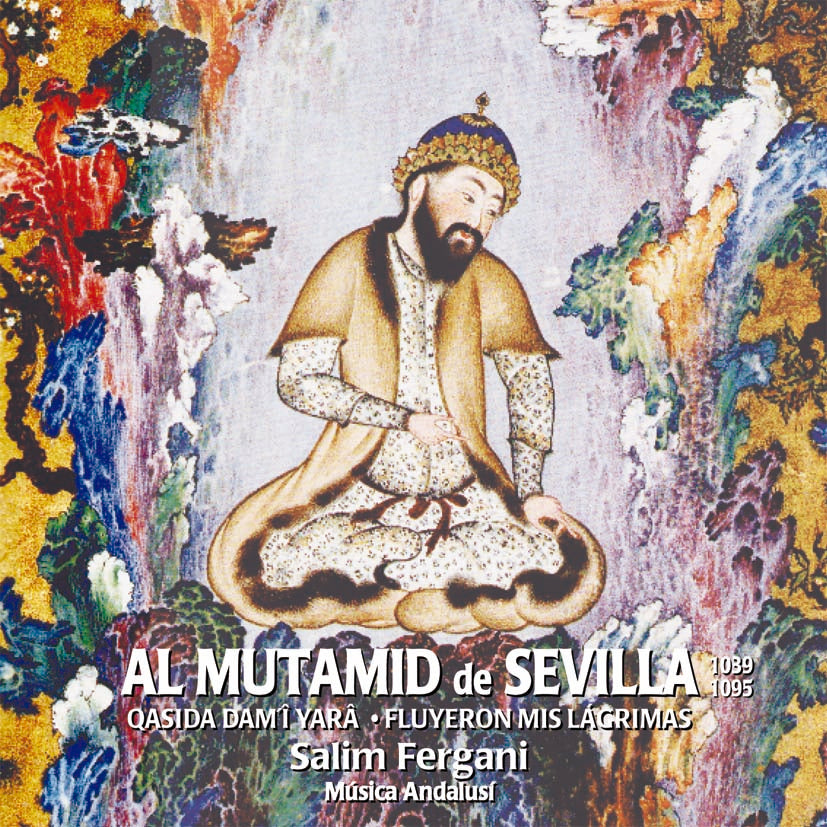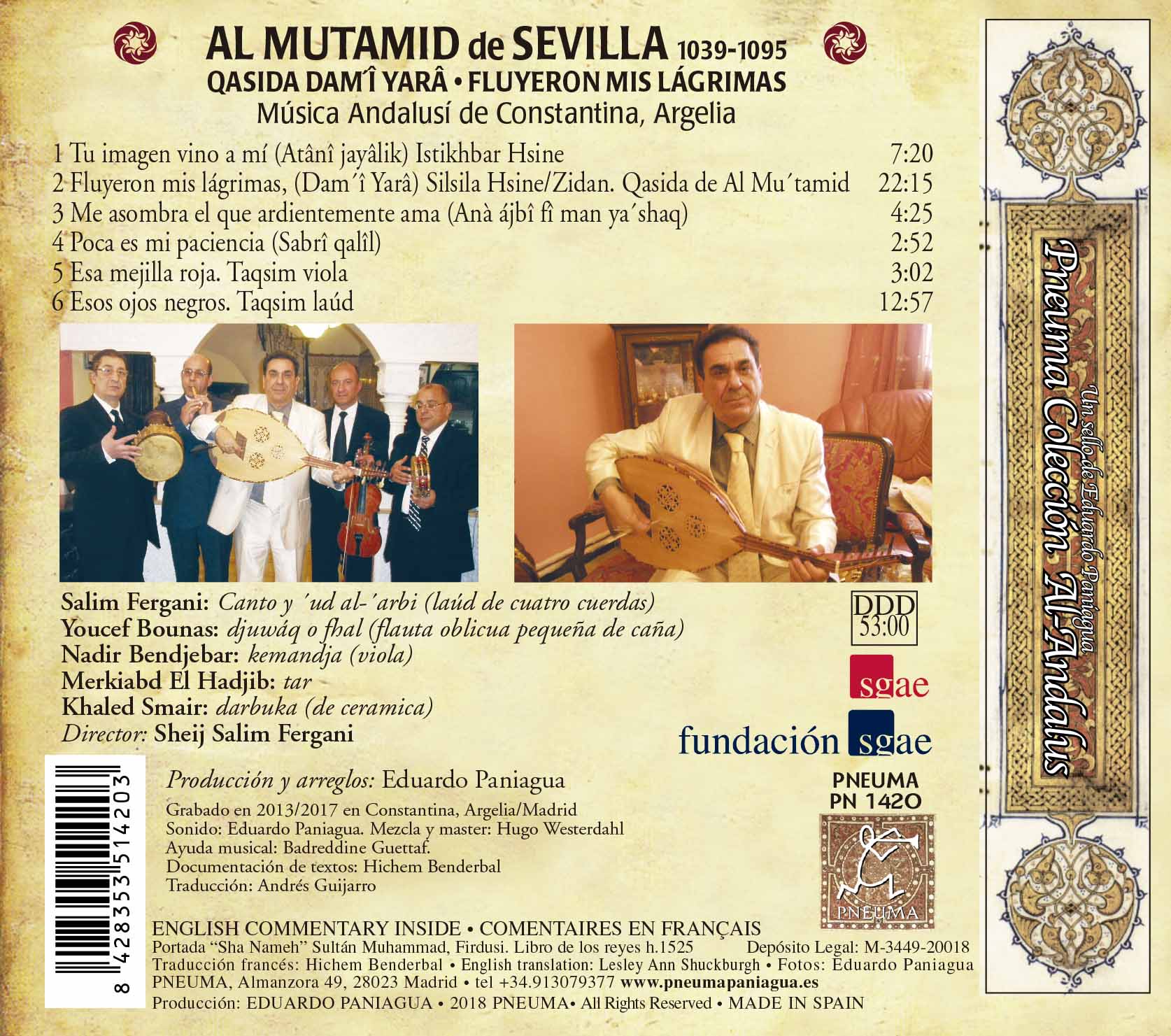pneumamusic
PN 1420 AL MUTAMID DE SEVILLA, QASIDA DAMÎ YAR
PN 1420 AL MUTAMID DE SEVILLA, QASIDA DAMÎ YAR
No se pudo cargar la disponibilidad de retiro
Índice
Índice
AL MUTAMID DE SEVILLA 1039-1095
QASIDA DAM´Î YARÂ • FLUYERON MIS LÁGRIMAS
Música Andalusí de Constantina, Argelia
1 Tu imagen vino a mí (Atânî jayâlik) Istikhbar Hsine 7:45
2 Fluyeron mis lágrimas, (Dam´î Yarâ) Silsila Hsine/Zidan. Qasida de Al Mu´tamid 22:39
3 Me asombra el que ardientemente ama (Anà ájbî fî man ya´shaq) 4:25
4 Poca es mi paciencia (Sabrî qalîl) 2:52
5 Esa mejilla roja. Taqsim viola 3:02
6 Esos ojos negros. Taqsim laúd 12:57
CONSTANTINA Y LA MÚSICA ANDALUSÍ
La música clásica árabe nace en Bagdad con el califa Mahdi Ibn al-Mansur en el año 775. Importada a España por Ziryab, esta música se independiza del mundo oriental y crea un nuevo estilo en al-Andalus al mezclarse con la música existente en la península ibérica. Es Ibn Báya (Avempace, m. 1138) el verdadero creador de la escuela arábigo-andaluza, que se desarrolla hasta la caída de Granada en 1492 y se mantiene, con pérdidas y nuevas aportaciones, en todo el Magreb.
Constantina es una de las escuelas herederas de la música arábigo-andaluza y tiene un singular repertorio debido a sus características históricas, a sus poetas autóctonos, a los maestros del siglo XIX y XX y a las cofradías religiosas que han conservado la moaxaja y el zéjel. Los turcos dejaron su impronta en la forma de la núba con la obertura llamada bashráf. La comunidad judía de Constantina, una de las más importantes en el norte de África, cultivó todo el repertorio arábigo andaluz, destacando en los géneros zdjúl y mahdjuz.
Constantina fue conquistada por los árabes y es con los fatimíes en el siglo IX cuando se comienza a citar su existencia. Con los ziríes y hammadíes, desde finales del siglo X a mitad del XII, fue cabeza de provincia. Durante los almorávides la ciudad no tiene especial relieve, pero con los hafsidas, a mediados del siglo XII, cobra importancia y desde mediados del XIII a mediados el XVI es la ciudad más importante de la zona, tras Túnez y Bugía. Cuando Bugía es tomada por los españoles en 1510, Constantina ostenta la capitalidad de toda la región. Túnez es conquistada por los turcos hacia 1553, y desde entonces Constantina no dependerá de Túnez sino de Argel, como capital de la Argelia turca. Desde 1563 el gobierno del caid o wali toma el nombre de bey, siendo elegido por el dey de Argel.
Hoy Constantina es la capital cultural del este de Argelia. Su patrimonio musical, trasmitido oralmente, es conocido y memorizado por la totalidad de los músicos tradicionales de la región, incluidas las ciudades de Annaba y Guelma. Este patrimonio se asienta en dos repertorios: el clásico y el popular, ambos con un papel esencial en la vida social e intelectual de Constantina. El repertorio clásico es denominado maluf o música arábigo-andaluza. El origen y significado de la palabra maluf es discutido: obra de arte, composición, “ma´ulifa samá uhu” (lo que es costumbre escuchar). El maluf comprende la música culta, refinada, clásica, que se interpreta en un área geográfica comprendida por Túnez, Libia y la región de Constantina en Argelia. En Constantina la base del maluf es la núba. Se trata de una composición con una introducción instrumental y múltiples canciones encadenadas, basada en un solo modo musical y cinco movimientos rítmicos. El repertorio clásico del maluf se complementa con otras obras denominadas silsila (cadena) o madjmía, y el inqiláb o naclab, un tipo de núba pequeña. Las poesías de estas composiciones tienen la forma moaxaja (muwashshah) y zéjel, que tienen su origen en la península ibérica y la qasida clásica árabe. Normalmente anónimas, su temática versa sobre el amor, la ebriedad, la belleza de la mujer, la descripción de la naturaleza y los momentos del día y la noche.
La formación tradicional clásica, además del canto, tiene cinco instrumentos: ´ud al-´arbi (laúd de cuatro cuerdas dobles afinadas en quintas embrazadas), djuwáq o fhal (flauta oblicua pequeña de caña), kemandja (viola), darbuka (tambor en forma de copa) y tár (pandereta).
LA SILSILA
La silsila (cadena), es una sucesión encadenada de poemas, precedidos de una introducción sin ritmo llamada istikbar. El istikbar es un canto improvisado, hecho al aire y con el sentimiento del momento en el que se encuentra el cantor. Tiene cuatro partes: introducción, desarrollo, djwáb y cierre o qufla. Entre estas partes discurren respuestas instrumentales también improvisadas y que suelen estar ordenadas en esta secuencia: laúd, fhal y viola. A diferencia de la núba, la silsila se desarrolla en hasta cuatro modos musicales y un solo ritmo, a lo sumo dos.
LA QASIDA DE AL MU´TAMID
Dentro del repertorio de las Silsila de Constantina existe una rareza, la qasida atribuida al rey sevillano de la época de los reinos de Taifas de Al-Andalus Al-Mu´tamid (1039-1095). Se trata de un largo poema único, con 6 estrofas más una salida, en el verso final firma el autor al modo trovadoresco. “Al-Mu‘tamid desea la paz a los presentes”.
El poema es un encuentro erótico-festivo muy del estilo de la primera etapa de Mu´tamid, joven príncipe de Silves. Es la historia de un ""voyeur"" (el principe), que al final seduce o es seducido por unas adolescentes algo cargaditas de alcohol y con ganas de vivir la vida en el momento. El escenario bucólico, de jardines, poesía y belleza, adorna el motivo poético y la expresividad del canto. Éste se intercala de respuestas instrumentales al uso, que conducen las escenas descriptivas de modo magistral.
La qasida tiene una introducción para canto libre e instrumentos sin ritmo, un istkhjbar, sobre el que Salim Fergani ha elegido el texto (Atânî jayâlik) “Tu imagen vino a mí en medio de la noche oscura, como un relámpago”. Como final de la qasida se añaden dos poemas anónimos cantados a ritmo ternario, típico del tiempo khlas (final) para el cierre de núba o la silsila. Se trata de “Me asombra aquél que ardientemente ama” (Anà ájbî fî man ya´shaq) y el famoso (Sabrî qalîl) “Poca es mi paciencia cuando pienso en esta pasión que me atormenta”.
AL MU´TAMID POETA Y REY
Muhammad ibn ‘Abbad al-Mu‘tamid, (1039-1095) fue rey de Sevilla (1069-1090). La corte sevillana de Al- Mu´tamid llegó al máximo nivel en la poesía, el lujo y el refinamiento de los Abadíes en los reinos de taifas. Los altos funcionarios lo fueron, no sólo por sus por sus habilidades políticas, sino por sus servicios poéticos continuados. Era imprescindible una corte de diplomáticos poetas en el ambiente de los palacios sevillanos de la época. Entre ellos Ibn Zeydun de Córdoba, Ibn Amar de Silves y el propio Mu´tamid. Sevilla fue el taifa más preocupado por la imagen de la corte, rivalizando con al Muzaffar Ibn al Aftas de Badajoz, al Ma´mun Ibn Dil Nun de Toledo y los Banu Hud de Zaragoza.
Se distinguen tres épocas en la vida de Al Mu´tamid y todas ellas se reflejan en su poesía, pues al ser rey no requería de mecenas, pudiendo expresar libremente sus sentimientos y vivencias. Alegre príncipe en Silves del Algarve portugués, rey guerrero en Sevilla, que agrandó a costa de los taifas vecinos y prisionero destronado en Agmat (Marrakech) por los almorávides, a los que había pedido ayuda al verse acosado por Alfonso VI rey de León y Castilla.
SALIM FERGANI
Salim Fergani proviene de una familia de artesanos y músicos. Su abuelo Hammou Fergani (1884-1972) fue maestro del hawzi. Salim nació justo antes de la trágica guerra de Argelia. En este duro medio social, desde los cinco años de edad aprendió de sus antecesores los maravillosos secretos del maluf. Su padre El Hadj Mohammed Tahar Fergani fue su primer maestro y su tío Zonaoui le introdujo en la interpretación del laúd arbí. Con estos elementos Salim ha logrado una nueva sensibilidad de interpretación de los antiguos poemas ejecutados en las tradicionales melodías, consiguiendo su propio estilo y personalidad. Giras por todo el mundo le han dado una dimensión internacional y el apodo de “El trovador de Constantina”. Salim interpreta magistralmente todos los géneros tradicionales del canto: maluf, silsila, hawzi, mahdjúz, ´rúbí, qadriya y zdjúl.
Descripción
Descripción
CONSTANTINE ET DE LA MUSIQUE ANDALOUSI
La musique arabe classique est née vers 775 à Baghdad, sous le règne du Khalife Mahdi Ibn al-Mansur. Ziryab l’introduit en Espagne, où, sous l’influence de la musique existante dans la péninsule ibérique, elle acquit indépendance envers le monde oriental et s’établit en al-Andalus comme un genre musical nouveau. Ibn Bajja (dit Avempace, décédé vers 1138) fut le véritable créateur de l’école arabo-andalouse, qui se développa jusqu’à la chute de Grenade en 1492, et qui se maintient, avec pertes et nouveautés, dans tout le Maghreb.
Constantine est une des écoles héritières de la musique arabo-andalouse, ayant un répertoire singulier dû à ses traits historiques, et grâce à ses poètes autochtones, dont Ibn al-Jaluf (XVe siècle), les maîtres du XIXe et du XXe, et les confréries religieuses qui ont conservé la muwashshah et le zadjal.
Constantine fut conquise par les arabes et ce fut au IXe siècle, avec la dynastie Fatimide, quand son existence commença d’être signalée. Sous le gouvernement des dynasties Ziride et Hammadite, dès la fin du Xe siècle jusqu’à la moitié du XIIe siècle, elle fut capitale de province. Sous les Almoravides, la ville ne brilla pas spécialement; cependant, avec la dynastie des Hafcides, elle acquit prépondérance, et dès la moitié du XIIe siècle jusqu’à la moitié du XVIe elle a été la ville la plus importante de la région, après Tunis et Bejaïa. Quand les espagnols conquirent Bejaïa en 1510, Constantine devint la capitale de toute la zone. Les Turcs conquirent la Tunisie vers 1553, et dès lors Constantine cessa de dépendre de Tunis et se soumit à Alger, comme capital de l’Algérie turque. Dès 1563 le gouvernement caïd ou wali prit le nom de bey, élu par le dey d’Alger.
Constantine est la capitale culturelle de l’Est algérien. Tous les musiciens traditionnels de la région, comprenant les villes de Annaba et Guelma, connaissent son patrimoine musical, transmis par tradition orale, qu’ils gardent dans leur mémoire. Ce patrimoine se fonde sur deux répertoires: le répertoire classique et le répertoire populaire, tous deux jouant un rôle essentiel dans la vie sociale et intellectuelle de Constantine.
Le répertoire classique s’appelle malouf ou musique arabo-andalouse. L’origine et la signification du terme maluf demeure incertain: oeuvre d’art, composition, “ma´ulifa samá uhu” (“ce que l’on écoute conforme à la tradition”). Le maluf comprend la musique culte, raffinée, classique, interprétée dans une région géographique comportant la Tunisie, la Libye et la région de Constantine à Algérie.
À Constantine, le maluf se fonde sur la nouba. Il s’agit d’une composition avec une introduction instrumentale et des nombreuses chansons enchaînées, fondée sur un seul mode musical et cinq mouvements rythmiques. Le répertoire classique maluf a pour complement d’autres ouvrages nommés silsila ou madjmía, et le inqiláb ou niqlab, un genre de núba plus courte. Les poésies de ces compositions ont pour forme la moaxaja (muwashshah) et le zadjal, tous deux originaires de la péninsule ibérique. Normalment anonymes, elles chantent pour la plupart l’amour, l’ivresse, la beauté de la femme, la description de la nature et l’arrivée du jour ou de la nuit.
La formation traditionnelle classique utilise, à part le chant, cinq instruments: ud al-´arbi (luth à quatre cordes doubles accordé en quintes successives), djuwáq ou fhal (petite flûte oblique en roseau), kemandja (viole), darbuka (tambour en forme de coupe) et tár (tambourin).
LA SILSILA
La silsila (“chaîne”) est une succession enchaînée de poèmes, précédés d’un istikhbar. L’istikbar est un chant improvisé, composé sans accompagnement musical, selon le sentiment ressenti par le chanteur à ce moment-là. Il comprend quatre parties: introduction, développement, djwáb et fermeture ou qufla. Des réponses instrumentales, également improvisées, se déroulent entre ces parties. Elles sont ordinairement ordonnées selon la séquence suivante: luth, fhal et viole.
SALIM FERGANI
Par son appartenance à une lignée d´artisans et de musiciens ayant comme référence son grand-père Hammou Fergani, maître du hawzi (1884-1972), à une famille dont l´enracinement artistique existe pendant plus d´un siècle. Né juste avant les événements tragiques de la guerre d´Algérie, Salim, malgré un environnement social très difficile, connut les bienfaits du Malouf déjà à l´âge de 5 ans, quand il interpréta son premier morceau. Son père El-Hadj Mohammed Tahar Fergani a joué un rôle prépondérant dans sa formation. Le premier de ses maîtres, il lui apprit à interpréter le Malouf. Son oncle Zouaoui l’initia aux secrets de la technique du luth arabe. Influencé par ces deux personnalités, Salim s´est créé son genre, son cachet. Les tournées de l’artiste autour du monde lui ont effectivement donné sa vocation réelle de “troubadour de Constantine” de dimension internationale. Salim excelle dans l´interprétation de tous les genres de chants : maluf, silsila, hawzi, mahdjúz, ´rúbí, qadriya et le zdjúl.
AL MU´TAMID POET AND KING
Muhammad ibn ‘Abbad al-Mu‘tamid (1039-1095) was king of Seville (1069-1090) and his Sevillian court excelled in the poetry, luxury and refinement typical of the Abbadids in the Taifa kingdoms. High officials held office not only by reason of their political ability, but also because of their continued poetic service. A court of poet diplomats was essential in the atmosphere of the Sevillian palaces of the time. Among them was Ibn Zeydun from Cordoba, Ibn Amar from Silves and Mu´tamid himself. Of all the Taifas Seville was the most concerned with the image of the court, rivalling Muzaffar Ibn al Aftas in Badajoz, Ma´mun Ibn Dil Nun in Toledo and the Banu Hud in Zaragoza.
There were three distinct periods in Al Mu´tamid’s life, all reflected in his poetry, since being king he did not need a patron, and was able to freely express his feelings and experiences. Joyful prince in Silves on the Portuguese Algarve, warrior king in Seville, which he expanded at the expense of the neighbouring Taifas, and prisoner in Agmat (Marrakech), dethroned by the Almoravids, who he had asked for help when attacked by Alfonso VI king of León and Castile.
CONSTANTINE AND ANDALUSI MUSIC
Classical Arab music was born in Baghdad during the Caliphate of Mahdi Ibn al-Mansur in the year 775. Ziryab brought this music to Spain where it became established independently of the oriental world and a new style evolved as a result of the fusion with the music already present in the Iberian Peninsula. Ibn Baya (Avempace, d.1138) was the true creator of the Arab-Andalusian school, which developed until the fall of Granada in 1492 and is still found across the whole of the Maghreb in its original form, give or take a few losses and additions.
The Constantine school is one that has inherited Arab-Andalusian music and boasts a special repertoire owing to its historical characteristics - local poets, such as Ibn al-Jaluf (15th century), the masters of the 19th and 20th centuries and the religious brotherhoods that have preserved the muwashshah and the zajel.
Conquered by the Arabs, Constantine is first mentioned in the 9th century at the time of the Fatimids. It was the provincial capital with the Zirids and the Hammadids between the end of the 10th and the middle of the 12th century. At the time of the Almoravids the town was of no special significance, but with the Hafsids, in the mid-12th century, it gained importance and from the mid-13th century to the mid-16th century it was the most important town in the area, after Tunis and Bejaia. When Bejaia was taken by the Spanish in 1510, Constantine became the capital of the whole region. Tunisia was conquered by the Turks in about 1553 and Constantine ceased to be part of Tunisia to become the capital of Turkish Algeria, under Algiers. From 1563 the Caid or Wali, who led the government, became known as the Bey, and was appointed by the Dey of Algiers.
Constantine is the cultural capital of eastern Algeria. Its musical heritage, passed down through the oral tradition, is well known by all the traditional musicians in the region, including the towns of Annaba and Guelma. This heritage is based on two repertoires: the classical and the popular, both with an essential role in the social and intellectual life of Constantine.
The classical repertoire is known as the maluf or Arab-Andalusian music. There is debate about the origin and meaning of the word maluf. Work of art, composition, “ma’ulifa samá uhu” (customary to listen to). The maluf includes the cultured, refined, classical music that is performed in the area covered by Tunisia, Lybia and the Constantine region in Algeria.
In Constantine the nubah forms the structural base of the maluf . The nubah is a composition with an instrumental introduction and several connected vocal pieces, based on just one musical mode and five rhythmic movements. The classical repertoire of the maluf is complemented by other works known as the silsila or madjmia and the inqilab or naclab, a shorter version of the nubah. The poems used for lyrics in these compositions are in the muwashshah and zajel form that originate in the Iberian Peninsula. Normally anonymous, they are usually about love, inebriation, female beauty, the description of nature and the times of the day and night.
In addition to chant, the traditional classical formation has 5 instruments, the ´ud al-´arbi (a four-course lute tuned in “embraced” fifths), djuwáq or fhal (small oblique reed flute), kemandja (viola), darbuka (drum in the shape of a goblet) and tar (tambourine).
THE SILSILA
The silsila (or chain) is a succession of linked poems, preceded by an istikbar. The istikbar is a spontaneous improvised chant that reflects the singer’s feelings at the time. It has four parts, a beginning, the development, djwab and an end or qufla. The intermittant instrumental responses are also improvised, the lute playing first, then the fhal and then the viola.
THE QASIDA OF AL MU´TAMID
There is a rare piece within the repertoire of the Constantine Silsila, the qasida, attributed to the Sevillian king of the Taifa kingdom era of Al-Andalus, Al -Mu´tamid (1039-1095). It is a long poem, with 6 verses and a conclusion. In the last line the author signs off like a troubadour “Al-Mu‘tamid wishes peace to all those present”.
The poem is a meeting of the erotic and the festive, very much in the style of Mu’tamid’s first period as the young prince of Silves. It is the story of a “voyeur” (the prince), who finally seduces or is seduced, by some adolescent girls, rather the worse for alcohol and wanting to live for the moment. The bucolic scene, with gardens, poetry and beauty, adorns the poetic motif and the eloquence of the chant. The chant is interspersed with the usual musical responses that lead the descriptive scenes masterfully.
The qasida has an introduction for free chant and instruments without rhythm, an istkhjbar, to which Salim Fergani has put the words (Atânî jayâlik) “Your image came to me in the middle of a dark night, like lightning”. Two anonymous poems have been added as a finale to the qasida for the close of the nubah or the silsila and sung in ternary rhythm, typical of khlas (final) tempo. These are “I am amazed by he who loves ardently” (Anà ájbî fî man ya´shaq) and the famous (Sabrî qalîl) “My patience is short when I think of this passion that torments me”.
SALIM FERGANI
Salim Fergani comes from a family of craftsmen and musicians. His grandfather Hammou Fergani (1884-1972) was master of the hawzi. Salim was born just before the tragic war in Algeria. From the age of 5 he studied the marvellous secrets of the Maluf from his predecessors in this difficult social environment. His father El Hadj Mohammed Tahar Fergani was his first master and his uncle Zonaoui introduced him to the arbi lute. This background has helped Salim become more sensitive to the way the ancient poems are performed on the traditional melodies, creating his own style and personality. World tours have given him an international dimension and the nickname “The Troubadour of Constantine”.
Salim masters all the traditional genres of chant: maluf, silsila, hawzi, mahdjúz, ´rúbí, qadriya y zdjúl.
Compartir


-
Envío gratis en pedidos mayores a 50 €.
Entrega en 5-7 días laborables para pedidos en España, en el caso de envíos fuera de España el tiempo de envío podría ser algo mayor.
-
Todo el trabajo de Pneuma Music se ha realizado en España.
Música medieval española inédita hasta el momento. Sus discos, con formato Digipack de cubierta de cartón y libreto interior (bilingüe + idioma original), quieren acercarse a una obra de arte total.


